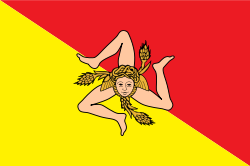Summary | Excerpt | Reviews | Beyond the Book | Read-Alikes | Genres & Themes | Author Bio

This article relates to Auntie Poldi and the Sicilian Lions
 Auntie Poldi, in Mario Giordano's Auntie Poldi and the Sicilian Lions, is intrigued when she encounters an unusual tattoo on the murder victim. It's Sicily's trinacria, an heraldic-style image whose origins linger in the shadows of Greek mythology.
Auntie Poldi, in Mario Giordano's Auntie Poldi and the Sicilian Lions, is intrigued when she encounters an unusual tattoo on the murder victim. It's Sicily's trinacria, an heraldic-style image whose origins linger in the shadows of Greek mythology.
Heraldry (the art of devising and displaying armorial insignia) may have begun on the battlefield as a means of identifying a rally point for warriors, or the warriors' allegiance. It's an easy assumption that heraldry could pre-date the written word and historical records. One royal house may have chosen lions rampant, for example, and another the fleur-de-lis, which are both emblems of nobility, bravery, and strength. There are dozens of these ancient emblems that first may have been identified with ethnic groups, then nations – think the Celtic knot, the cross, and the fylfot (a primitive swastika.) The trinacria, harkens back to the triskelion, an image consisting of three spirals which illustrate rotational symmetry. The triskelion is found in many early cultures. The earliest known use is in Malta around 4400–3600 BC, and it was also found in the astronomical calendar at the tomb of Newgrange in Ireland around 3200 BC, as well as on coins in Lycia (now the southern coast of Turkey) to name a few.
The mysterious trinacria makes a bold statement. The oddly surreal and darkly humorous three legs waving from the ramparts were sure to draw the eye and capture attention. It references the number three, evident by the three legs, and also a triangle. Glancing at a map, its evident that Sicily – the largest island in the Mediterranean – is roughly triangular in shape. Each leg stands stalwart on the seabed supporting the island's corners. It is believed that the Sicilians went one step further, adding Medusa's head to the national symbol, a simple enough choice once we recognize Medusa is the protector of Athena, Patron Goddess of Sicily.
While the trinacria's three legs represent Sicily, it also has other meanings when used in the context of other cultures. For example, the Isle of Man's emblem is very similar, but the three legs on the island's flag are said to signify the passage of the sun across the sky. The Isle of Man's trinacria has the three legs encased in armor, including spurs for the armored heels. Oddly, the Isle of Man is over 3,000 kilometers from Sicily. Perhaps commerce or a diplomatic mission lost to history resulted in the two places having the same emblem.
In 1943, the trinacria became part of the official flag of Sicily; a symbol of resistance and freedom from Mussolini's national socialism. Sicilians seem to owe their flag of the island to a man named Andrea Finocchiaro Aprile, head of Movimento per I'Indipendeza della Sicilia, a group who fought heroically against the Fascist dictator Mussolini and for the Allied cause in World War II.
Filed under Cultural Curiosities
![]() This "beyond the book article" relates to Auntie Poldi and the Sicilian Lions. It originally ran in March 2018 and has been updated for the
February 2019 paperback edition.
Go to magazine.
This "beyond the book article" relates to Auntie Poldi and the Sicilian Lions. It originally ran in March 2018 and has been updated for the
February 2019 paperback edition.
Go to magazine.






Your guide toexceptional books
BookBrowse seeks out and recommends the best in contemporary fiction and nonfiction—books that not only engage and entertain but also deepen our understanding of ourselves and the world around us.